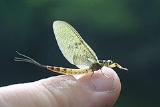
Paleoptera
Encyclopedia
The name Palaeoptera has been traditionally applied to those primitive groups of winged insects (most of them extinct) that lacked the ability to fold the wings back over the abdomen
as characterizes the Neoptera
. The complexities of the wing-folding mechanism, as well as the mechanical operation of the wings in flight (indirect flight muscles
), are such that it clearly indicates the Neoptera are a monophyletic lineage. The Diaphanopterodea
, which are palaeopteran insects, had independently and uniquely evolved
a different wing-folding mechanism.
The problem is that the plesiomorphic absence of wing-folding does not necessarily mean the Palaeoptera form a natural group – they may simply be an assemblage containing all insects, closely related or not, that "are not Neoptera", an example of a wastebasket taxon. As it stands, the relationship of the two living Paleopteran groups – Ephemeroptera (mayflies) and Odonata
(dragonflies and damselflies) – to the Neoptera has not been resolved yet; there are three competing main hypotheses with many variations. In two of these – those that treat the ephemeropteran or the odonatan lineage as closer to the Neoptera than to the other "palaeopterans" – the Paleoptera appear to be paraphyletic and thus an artificial grouping that is best abandoned.
If the extinct lineages are taken into account, it seems likely that the concept of Palaeoptera will eventually be discarded or changed in content to more accurately reflect insect evolution. In any case, three main palaeopteran lineages, traditionally treated as superorders, are recognized. Of these, the Palaeodictyopteroidea themselves might be a paraphyletic assemblage of very basal Pterygota
, too.
Abdomen
In vertebrates such as mammals the abdomen constitutes the part of the body between the thorax and pelvis. The region enclosed by the abdomen is termed the abdominal cavity...
as characterizes the Neoptera
Neoptera
Neoptera is a classification group that includes almost all the winged insects, specifically those that can flex their wings over their abdomens...
. The complexities of the wing-folding mechanism, as well as the mechanical operation of the wings in flight (indirect flight muscles
Insect flight
Insects are the only group of invertebrates known to have evolved flight. Insects possess some remarkable flight characteristics and abilities, still far superior to attempts by humans to replicate their capabilities. Even our understanding of the aerodynamics of flexible, flapping wings and how...
), are such that it clearly indicates the Neoptera are a monophyletic lineage. The Diaphanopterodea
Diaphanopterodea
The Diaphanopterodea or Paramegasecoptera are an extinct order of moderate to large-sized Palaeozoic insects. They are first known from the Middle Carboniferous , and include some of the earliest known flying insects.-Overview:Despite their very early appearance in the insect fossil record, they...
, which are palaeopteran insects, had independently and uniquely evolved
Convergent evolution
Convergent evolution describes the acquisition of the same biological trait in unrelated lineages.The wing is a classic example of convergent evolution in action. Although their last common ancestor did not have wings, both birds and bats do, and are capable of powered flight. The wings are...
a different wing-folding mechanism.
The problem is that the plesiomorphic absence of wing-folding does not necessarily mean the Palaeoptera form a natural group – they may simply be an assemblage containing all insects, closely related or not, that "are not Neoptera", an example of a wastebasket taxon. As it stands, the relationship of the two living Paleopteran groups – Ephemeroptera (mayflies) and Odonata
Odonata
Odonata is an order of insects, encompassing dragonflies and damselflies . The word dragonfly is also sometimes used to refer to all Odonata, but the back-formation odonate is a more correct English name for the group as a whole...
(dragonflies and damselflies) – to the Neoptera has not been resolved yet; there are three competing main hypotheses with many variations. In two of these – those that treat the ephemeropteran or the odonatan lineage as closer to the Neoptera than to the other "palaeopterans" – the Paleoptera appear to be paraphyletic and thus an artificial grouping that is best abandoned.
If the extinct lineages are taken into account, it seems likely that the concept of Palaeoptera will eventually be discarded or changed in content to more accurately reflect insect evolution. In any case, three main palaeopteran lineages, traditionally treated as superorders, are recognized. Of these, the Palaeodictyopteroidea themselves might be a paraphyletic assemblage of very basal Pterygota
Pterygota
Pterygota is a subclass of insects that includes the winged insects. It also includes insect orders that are secondarily wingless ....
, too.

